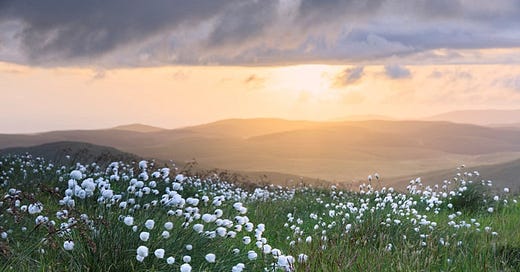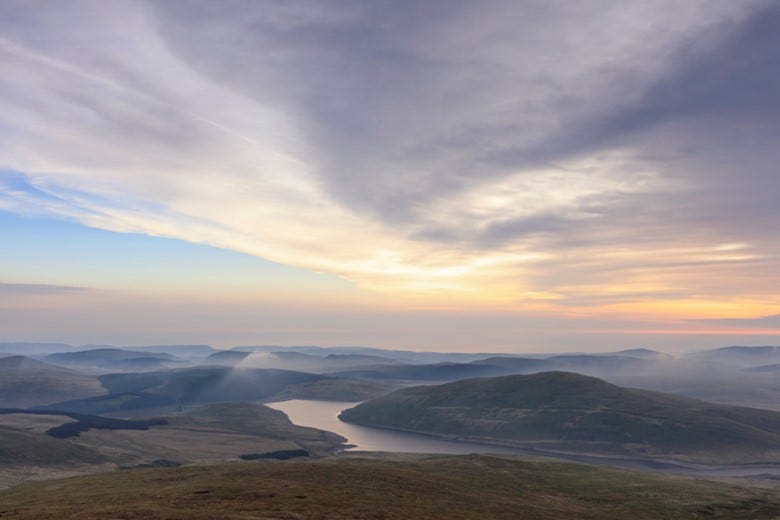Steeped in history and myths, there are five different walking trails to reach the summit of Pumlumon Fawr. At 752m (2467ft) high, it is the highest of the five peaks of the Cambrian Mountains massif. The “Pig Trail” follows Nant y Moch (the stream of the pigs). The1Mabinogion tells how the magician Gwydion stole otherwordly pigs from Pryderi, a prince of Dyfed, and escaped north, stopping overnight at a site known as Mochdre in north Ceredigion. Today, the stream feeds into the Nant y Moch reservoir, which forms part of the Rheidol Hydroelectric scheme, completed in 1964. The scheme, now operated by Statkraft, is the largest in Wales.
Lluest Y Gwynt Wind Farm is planned for the northern section of Ceredigion. It is a partnership between Statkraft and Eco2 and is located near the village of Ponterwyd, east of Aberystwyth, on the slopes of Pumlumon.
It has been in the pipeline since 2020. It is now in its statutory consultation phase, which will conclude on February 12, 2025. This marks the final consultation period before the submission of their planning application.
Originally presented as a 28 turbine project, the proposal has been reduced to 12. The developers are working to this timeline.
June 2025 - Pre-application consultation process finishes.
June 2027 - Decision expected after the Inspector has examined the application and made a recommendation to the Welsh Government, who will then decide.
June 2028 - Construction of the wind farm is expected to commence. It is likely to take around 18 months.
June 2030 - Operation of the Wind Farm is expected to commence.
Two face-to-face public consultations are scheduled:
Syr John Rhys School, Ponterwyd, SY23 3JX
Wednesday, 29th January 2025, 4pm to 8pm
Llangurig Community Centre, Llangurig, SY18 6SG
Thursday, 30th January 2025, 10am to 2pm
Access a non-technical summary of the proposals here
Access a photo montage of the visual impact from Pumlumon Fawr here
This “Visit Wales” promotional video for Pumlumon Fawr highlights the impact that Lluest Y Gwynt would have on this environmentally sensitive area. The slopes of Pumlumon host the sources of the rivers Wye and Severn. The video briefly glimpses the Cefn Croes turbines from the summit, which are no higher than 100m. The 12 turbines planned for Lluest Y Gwynt are 180m high. It is also worth noting that the Cambrian Way is again impacted as it passes within the site boundary.
For similar projects that have already passed through the PEDW fast-track planning system, we hear, “Decision makers must prioritise the Welsh Government’s renewable energy targets. These goals are more important than any possible negative impacts.”
It is important to respect Wales' wild landscapes. Who is weighing the cumulative impact of all the harm to our landscapes and biodiversity, agriculture and tourism, the rural economy, heritage, and the well-being of our communities now and for future generations?
This is just one of the vast number of renewable energy plans entering the planning system for Rural Wales. Look at the map of wind farms and planned pylon routes in Wales, which is updated as we become aware of new or revised proposals.
The map is best viewed on a large screen. It has layers you can add or remove to better understand the bigger picture. Zoom in or out to see how these projects might impact you and your community.
Please help us protect these wonderful landscapes. How can destroying them possibly help to save the planet?
“Some restraint must be put on these dictatorial energy developers and their acolytes, whose aim is to cover the whole of Wales with turbines, and all for such pathetic amounts of intermittent energy.” Jan 2012
David Bellamy
Aberedw, Radnorshire
The Mabinogion is a collection of the earliest Welsh prose stories, compiled in Middle Welsh in the 12th–13th centuries from earlier oral traditions.







The problem is officialdom, who have a very poor understanding or knowledge of generation. This includes the government, and local councils tend to be more zealous.
Trying to get the message to officaldom that wind generators are not the same as conventional for practical and technical reasons and cannot replace conventional generators, and the false message that they are cheap is going to take some overcoming.
The only people who benefit are the wind farm owners who gett well paid for their second rate electricity.
The media is no help as they are as cluless, and their phrases like enormous machines or giant generators when in fact they are puny devices compared to 'proper' generators especially given their very low availability figures circa 20% for on shore wind.
This I cannot see changing until there is a dominant political party who do not support renewables.
It may be a long wait.
The other message that CO2 is not what controls climate is going to be even harder to get across to those who make decisons such as this?
Excellent article, Annie. Thank you!